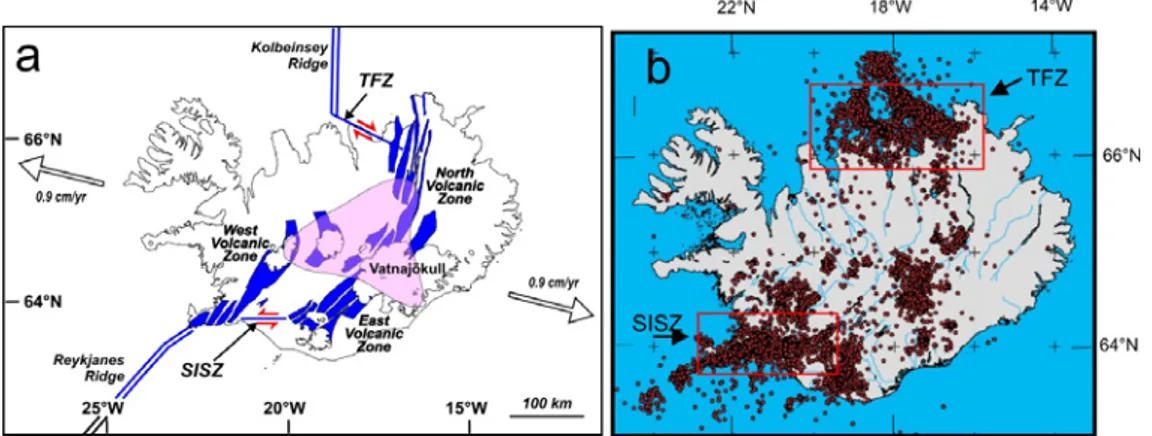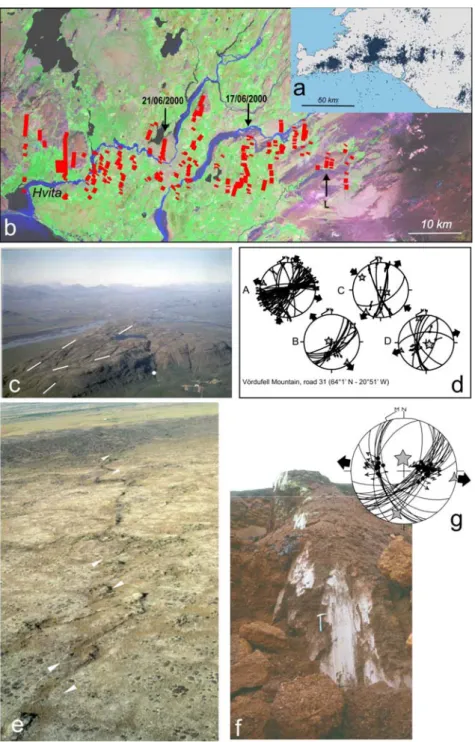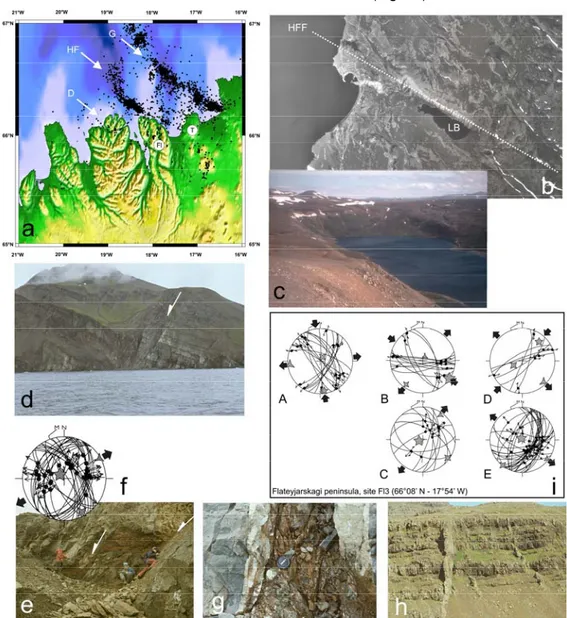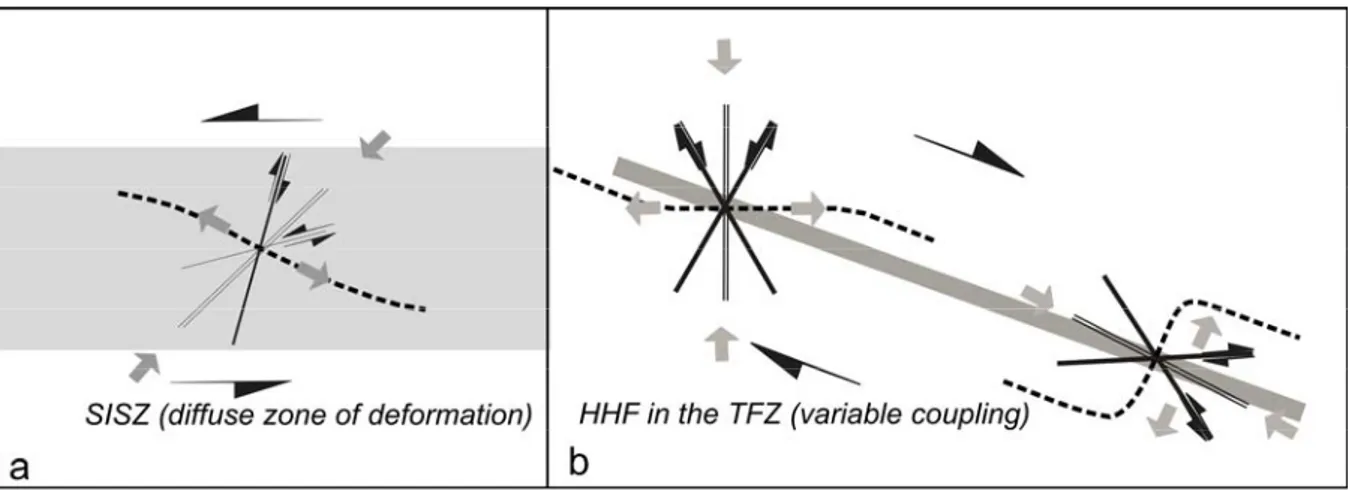HAL Id: hal-00480616
https://hal.univ-brest.fr/hal-00480616
Submitted on 4 May 2010HAL is a multi-disciplinary open access archive for the deposit and dissemination of sci-entific research documents, whether they are pub-lished or not. The documents may come from teaching and research institutions in France or abroad, or from public or private research centers.
L’archive ouverte pluridisciplinaire HAL, est destinée au dépôt et à la diffusion de documents scientifiques de niveau recherche, publiés ou non, émanant des établissements d’enseignement et de recherche français ou étrangers, des laboratoires publics ou privés.
Recent and present-day tectonics near a hot spot : the
transform zones of iceland
Françoise Bergerat, Jacques Angelier, Catherine Homberg, Sebastian Garcia,
S. Verrier, Magalie Bellou
To cite this version:
Françoise Bergerat, Jacques Angelier, Catherine Homberg, Sebastian Garcia, S. Verrier, et al.. Recent and present-day tectonics near a hot spot : the transform zones of iceland. Iceland in the Central Northern Atlantic : hotspot, sea currents and climate change, May 2010, Plouzané, France. �hal-00480616�
RECENT AND PRESENT-DAY TECTONICS NEAR A HOT SPOT: THE
TRANSFORM ZONES OF ICELAND.
F. Bergerat*, J. Angelier †, C. Homberg, S. Garcia, S. Verrier and M. Bellou
* CNRS, UMR 7193, ISTeP, Case 117, 4 place Jussieu, F-75252 Paris cedex 05, France. Courriel : Francoise.bergerat@upmc.fr
Abstract
The two transform zones that connect the Icelandic rift segments and the mid-Atlantic Ridge close to the Icelandic hot spot, are described in terms of geometry of faulting and stress fields. They differ in age: 8-8.5 My in the north and 2-3 My in the south, illustrating the different stages of maturity in the transform process, from an immature stage illustrated by the South Iceland Seismic Zone to a mature stage shown by the Husavik-Flatey Fault.
Introduction
The existence of Iceland, as a major volcanic island on top of the Mid-Atlantic Ridge, results from the interaction between the Icelandic hot spot and the Mid-Atlantic Ridge across which spreading occurs at a rate of ~1.9 cm/yr. The boundary between American and Eurasian plates has moved westwards with respect to the Icelandic hot spot. However, due to successive rift jumps, the present-day axial rift zone in Iceland remains roughly centred above the apex of the hot spot (Fig.1a). Therefore, the Icelandic rift is shifted more than 100 km eastwards with respect to the general spreading axis.
Figure 1 – (a) Iceland and the Mid-Atlantic Ridge. In black, the Icelandic rift. Grey triangular shape, extension of the hot spot at 400 km depth. Open arrows, direction and velocity of plate divergence. (b) Present day seismicity of Iceland: earthquakes of magnitude equal or superior to 1 for the period 1994-2002. SISZ : South Iceland Seismic Zone, TFZ: Tjörnes Fracture Zone.
The latest jumps differ in age in northern and southern Iceland: 8-8.5 My and 2-3 My, respectively. As a consequence, two major transform zones presently connect the Icelandic rift segments and the oceanic ridge, which are not at the same stage in their development and display different fault and stress patterns, highlighting the different stages of maturity in the transform process.
The two transform zones: the South Iceland Seismic Zone, in the south, and the Tjörnes Fracture Zone, in the north, are partly exposed on land and, in addition, the Icelandic Meteorological Office supplies a large database of earthquakes since 1991. Most of the seismicity in Iceland is located in these transform zones (Fig. 1b). The past and present fault geometry and the mechanical behaviour in both these areas can thus be analysed.
The South Iceland Seismic Zone (SISZ)
The Plio-Pleistocene fault pattern in the SISZ ranges in trend between N-S and ENE-WSW (Fig. 2c): the N30°E-N40°E trend mainly corresponds to normal faulting or tension fractures, whereas the N0°E-N20°E trend correspond to right-lateral strike-slip faults and the N60°E-N70°E trend to left-lateral faults. In detail, four brittle tectonic regimes were reconstructed in the whole SISZ (Fig. 2d). The primary stress regime is characterized, for both the strike-slip faulting and the normal faulting, by a NW-SE average direction of extension, compatible with left-lateral motion along the SISZ, and clearly
prevails in terms of related brittle deformation (that is, numbers and sizes of minor faults). The second largest stress regime is characterised by a direction of extension NE-SW. Two other, less important, stress regimes display E-W and N-S directions of extension.
Figure 2 – Some aspects of the South Iceland Seismic Zone. (a) Earthquakes of magnitude equal or superior to 0.5 for the year 1995. (b) Surface traces of seismic strike-slip faults (in red) drawn on a Landsat image of the SISZ. The June 2000 earthquake (M = 6.6) are indicated as well as the Leirubakki Fault (L). (c) Example of the Holocene fault pattern in the SISZ: the Vördufell Mountain. White lines on the picture underline some major faults. (d) Paleostress determination in the Vördufell mountain. White dot on the photograph c indicates the measurement site. (e) Oblique aerial photograph of the Leirubakki Fault, a typical N-S trending right-lateral fault. (f) Outcrop photograph showing normal oblique-slip fault surfaces in scoriae of post-glacial volcano near Seydishólar. (g) Corresponding paleostress determination. Oblique aerial photograph c and e from A. Gudmundsson.
Considering the spatial distribution of earthquakes (Fig.2a-b), the SISZ is mainly affected by N-S major seismic faults. Some major fault ruptures, including the traces of the June 2000 large earthquakes (magnitude 6.6), have been mapped in detail. All these earthquake fault traces show right-lateral en-échelon patterns of fractures and push-up structures (Fig. 2e). The variety of focal mechanisms of earthquakes suggests that the whole set of mechanisms cannot correspond to a single stress regime. Mass inversions of large data sets of earthquake focal mechanisms in the SISZ indicate that a strike-regime with NW-SE extension and NE-SW extension clearly prevails, but however reveal a secondary, opposite, stress regime involving NE-SW extension and NW-SE extension.
The major fault geometry reveals consistency with a classical Riedel-type model of fault pattern in a left-lateral shear zone. The E-W trends are poorly developed in the brittle structures, despite the general E-W direction of the SISZ. The reason for this limited expression lies in the accommodation of the E-W lateral shear in a wide and diffuse zone of deformation (Fig. 4a).
Figure 3 – Some aspects of the Tjörnes Fracture Zone. (a) Earthquakes of magnitude equal or superior to 1 for the period 1993-2002 in the Tjörnes Fracture Zone. G: Grimsey Seismic Zone, HF: Húsavík-Flatey Fault, D: Dalvik Lineament, Fl: Flateyjarskagi peninsula, T: Tjörnes peninsula. (b) Aerial photograph of the Húsavík-Flatey Fault (HFF) across the Tjörnes peninsula. The Lake Botnsvatn (BL) is interpreted as a pull-apart structure along the fault. (c) Photograph of the Botnsvatn pull-apart. (d) and (e) Photographs showing normal faults in the Upper Miocene tholeitic basalts, along the northeastern coast of the Flateyjarskagi peninsula. (f) Corresponding paleostress determination. (g) Crushed rocks along the Dalvik line. (h) Dykes trending parallel to the HFF. (i) Example of analysis of a heterogeneous data set of minor faults in Upper Miocene tholeïtic basalts, at the north-eastern coast of Flateyjarskagi.
The Törnes Fracture Zone (TFZ)
Three tectonic lines constitute the TFZ, from north to south, respectively: the Grimsey Line, the Húsavík-Flatey Fault (HFF) and Dalvik Line (Fig. 3a). They trend parallel to the whole transform zone that is WNW-ESE on average. However, no transform-parallel major faults could be recognised with the exception of the HFF.
The main onshore feature of the TFZ is the HFF, which can be followed as a 25 km long morphological feature across the Tjörnes peninsula (Fig. 3b-c) and is well marked on the northern coast of the Flateyjarskagi peninsula by a large zone of crushed rocks associated with tilted blocks of lava pile and numerous strike-slip and normal faults. The structural complexity of the TFZ results from the important right-lateral deformation that produced more or less important block rotation in the vicinity of the major fault. All but few sites in the peninsula contain several fault subsets and thus reveal a high level of heterogeneity. As for the SISZ, four stress regimes can be identified (Fig. 3i), related to E-W, NE-SW, NW-SE and N-S extensions respectively. Each of these extensions is expressed through both strike-slip and normal-slip faulting and dykes. The most important extensions are compatible with the right-lateral general motion of the TFZ. One of these dominant stresses is characterised by an E-W extension, the other one corresponds to a NE-SW extension. The two other regimes are incompatible with the general motion of the TFZ, the trends of extension being N-S and NW-SE, respectively.
The HFF is characterised by a strong seismic activity (Fig. 3a) and some large magnitude earthquakes occurred (e.g., southwest of Húsavík in 1872, M = 6.3, and at its north-western tip in 1994, M = 5.5). Most seismic faults trend N122°E-N140°E and show right-lateral motion, however in its western part some N-S left-lateral seismic faulting also occurs. The two groups reflecting E-W and NE-SW extensions represent 43% and 39% of the total data set of seismic events.
The two dominant and transform-compatible stress states have been interpreted as revealing repeated changes from moderate mechanical coupling to very low across the transform fault zone. The two major directions of extension make angles of 20°-25° and 70°-85° with the transform direction. There is little evidence of intermediate situations, which suggests that the changes in coupling were abrupt rather than progressive during the transform history (Fig. 4b).
Conclusion
The fault patterns, as well as the related stress fields, show some similarities in both the SISZ and the TFZ. The most remarkable similarities are (i) the existence of extensional features accompanying strike-slip motion and (ii) the occurrence of minor stress states often opposite to the main ones (and thus incompatible with transform motion). However, major differences exist and reveal specific properties of these two zones. The general kinematics and geodynamics of Iceland did not change since, at least, the Miocene, so that these differences should be considered characteristic of the different stages in the transform process evolution. This contrast is a consequence of the difference in age between the two transform zones.
In terms of fault patterns, the organisation in the SISZ, that is youngest transform zone, may be characterised as diffuse in a wide area where no E-W trending major fault exists (Fig. 4a). Therefore, the SISZ can be considered as an immature transform zone and the geometrical pattern corresponds to the development of a classical Riedel-type pattern. Taking into account the southward propagation of the Easter Volcanic Zone in south Iceland, it is reasonable to predict a refocusing of the faulting activity towards a stronger consistency with the stress regime that prevails at the regional scale across the rift and transform zone segments, as might have happened in the TFZ.
In the Tjörnes fracture zone, which developed earlier, the earthquake distribution follows three major ESE-WNW trending lines. Especially, the HFF can be traced on land, as a tightly localised fault line. In detail, the geometrical fault pattern is certainly more complex as seismic faults characterised along the Dalvik and Grimsey alignments trend N-S to NNE-SSW, as left-lateral strike-slip faults. This complexity suggests that the TFZ actually includes different fault domains at different stages of maturity. The slip distribution and the crustal stress field geometry have been simulated using a 2D numerical modelling. It shows that, at any time during the development of the plate boundary, the plate motion is not distributed along each of the plate boundary faults but mainly occurs along a single master fault. The finite width of the TFZ results from slip transfer through time with locking of early faults, not from a permanent distribution of deformation over a wide area. Because of fault interaction, the stress field geometry within the TFZ is complex and includes stress deflections close to but also
away from the major faults. Comparison between paleostress reconstructions and results of modelling suggests that the Dalvik Fault and the Husavik-Flatey Fault developed first, the Grismsey Fault being the latest active structure. Since initiation of the TFZ, the Husavik-Flatey Fault accommodated most of the plate motion and probably persists until now as the main plate structure. Because the Icelandic rift is propagating northward, the Grimsey Seismic Zone will probably reach to a major role in the transform process, developing as a true fault line and maybe replacing the HFF as the major structure of the TFZ in the future.
Figure 4 - Schematic pattern of faulting and associated average stresses (a) in the SISZ and (b) along the HFF. Solid lines with indication of the sense of shear: strike-slip faults; thin double lines: normal faults; convergent and divergent grey arrows: directions of compression and extension, respectively. Pairs of black arrows indicate the transform motion. The two fault and stress patterns along the HFF do not refer to different locations but illustrate the two major stress regimes.
To conclude, Iceland provides a unique opportunity to compare immature and mature transform zones on land (totally in the SISZ, partly in the TFZ) and using seismological data. This comparison demonstrates that the trend of the transform motion, as reflected in the major features, is hidden at the beginning of the transform process and develops when the transform zone becomes mature. The geometry related to the immature stage shows a diffuse shear zone with a Riedel-type pattern of faults, with a dominating stress field that reflects the behaviour of the transform zone. At the mature stage, the geometry becomes simpler, with the development of a well-localised shear fault zone where most of the transform process concentrates, but a complex stress pattern prevails with major variations in friction along the fault and different stress states that reflect abrupt changes in mechanical coupling, probably as a function of the major magmatic crises. To this respect, it is likely that not only does the Icelandic hot spot induce rift jumps; it also significantly influences the behaviour of the transform faults.
This abstract benefited from discussions and field investigations with some French and Icelandic colleagues, especially: O. Bourgeois, O. Dauteuil, A. Gudmundsson, K. Saemundsson, R. Stefansson, B. Van-Vliet-Lanoe and T. Villemin.
References
This abstract is based on the following works of F. Bergerat, J. Angelier†, C. Homberg, S. Garcia, S. Verrier and M. Bellou. Only some other relevant references are given herein, but complete reference lists can be found in the most recent papers.
Angelier J. and Bergerat F., 2002. Behaviour of a rupture of the 21 June 2000 earthquake in South Iceland as revealed in an asphalted car park. Journ. Struct. Geol., 24, 1925-1936.
Angelier J., Bergerat F. and Homberg C., 2000. Variable coupling across weak oceanic transform fault : Flateyjarskagi, Iceland. Terra Nova,.12, 97-101.
Angelier J., Bergerat F., Stefansson R. and Bellou M.,2008. Seismotectonics of a newly formed transform zone near a hot spot: earthquake mechanisms and regional stress in the South Iceland Seismic Zone. Tectonophysics, 447, 95-116.
Angelier J., Slunga R., Bergerat F., Stefansson R. and Homberg C., 2004. Perturbation of stress and oceanic rift extension across transform faults shown by earthquake focal mechanisms in Iceland. E.P.S.L., 219, 271-284.
Bellou M., Bergerat F., Homberg C. and Angelier J., 2005. Geometry and segmentation mechanisms of the surface traces associated with the 1912 Selsund Earthquake, Southern Iceland. Tectonophysics, 404, 133-149.
Bergerat F. and Angelier J., 2003). Mechanisms of the June 2000 earthquakes, southern Iceland : inferences from surface traces of the Arnes and Hestfjall faults. Journ. Struct. Geol., 25, 1507-1523.
Bergerat F. and Angelier J., 2000. The South Iceland Seismic Zone : tectonic and sismotectonic analyses revealing the evolution from rifting to transform motion. Journ. Geodynamics, 29, 211-231.
Bergerat F., Angelier, J., 2008, Immature and mature transform zones near a hot spot: the South Iceland Seismic Zone and the Tjörnes Fracture Zone (Iceland). Tectonophysics, 447, 142-154.
Bergerat F., Angelier J. and Homberg C., 2000. Tectonic analysis of the Husavik-Flatey Fault (northern Iceland) and mechanisms of an oceanic transform zone, the Tjörnes Fracture Zone, Tectonics., 19, 1161-1177. Bergerat F., Angelier J. and Verrier S., 1999. Tectonic stress regimes, rift extension and transform motion : the
South Iceland Seismic Zone. Geodin. Acta, 12, 303-319.
Bergerat F., Gudmundsson A., Angelier J., and Rögnvaldsson S.Th.,1998. Seismotectonics of the central part of the South Iceland Seismic Zone. Tectonophysics,298, 319-335.
Bergerat F., Angelier J., Gudmundsson A. and Torfason H., 2003. Push-ups, fracture patterns, and paleoseismology of the Leirubakki Fault, South Iceland. Journ. Struct. Geol., 25, 591-609.
Einarsson, P., 1991. Earthquakes and present-day tectonism in Iceland. Tectonophysics 189, 261-279.
Einarsson, P., Khodayar, M., Clifton, A., Ófeigsson, B., Thorbjarnarson, S., Einarsson, B., Hjartardóttir, Á. R., 2005. A map of Holocene fault structures in the South IcelandSeismic Zone. Geophysical Abstract Research, vol. 7, Communication 08858.
Garcia S, Angelier J., Bergerat F. and Homberg C. ,2002. Tectonic analysis of an oceanic transform fault zone revealed by fault-slip data and earthquake focal mechanisms: the Husavik-Flatey Fault, Iceland. Tectonophysics, 344, 157-174.
GarciaS., AngelierJ., BergeratF., HombergC. and DauteuilO. , 2008. Influence of rift jump and excess loading on the structural evolution of Northern Iceland. Tectonics, 27, TC1006, doi: 10.1029/2006TC002029, 2008. Garcia S., Arnaud N., Angelier J., Bergerat F. and Homberg C., 2003. Rift Jump process in Northern Iceland since
10 Ma from 40Ar/39Ar geochronology. E.P.S.L., 214, 529-544.
Guðmundsson, Á., Brynjolfsson, S., 1993. Overlapping rift-zone segments and the evolution of the South Iceland Seismic Zone. Geophys. Res. Lett. 20, 18, 1903-1906.
Guðmundsson A., 2007, Infrastructure and evolution of ocean-ridge discontinuities in Iceland. Journal of Geodynamics, 43, 6-29.
Homberg C., Bergerat F., AngelierJ., Garcia S., 2010, Fault interaction and stresses along broad oceanic transform zone: Tjörnes Fracture Zone, north Iceland. Tectonics, 29, TC1002, doi:10.1029/2008TC002415.
Saemundsson, K., 1979. Outline of the geology of Iceland. Jökull, 29, 7-28.
Saemundsson, K. , 1974. Evolution of the Axial Rifting Zone in Northern Iceland and the Tjörnes Fracture Zone, Geol Soc Am. Bull., 85, 495-504.



